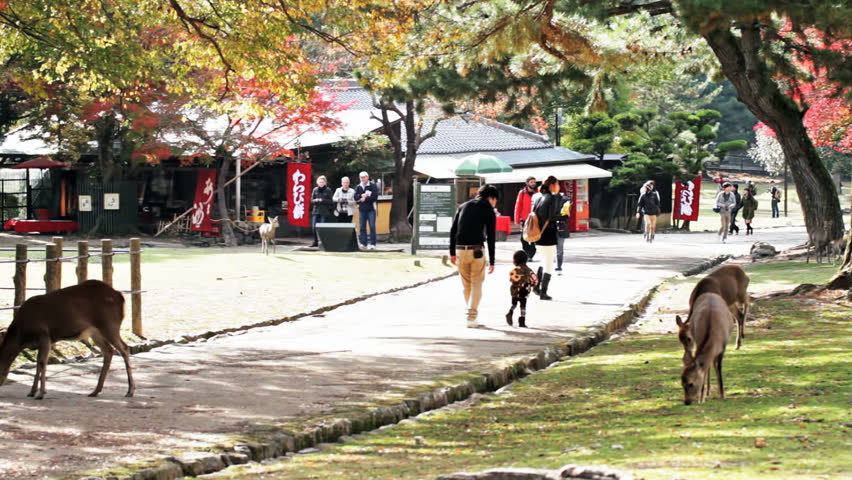Districts in Nara
Nara is home to hundreds of fascinating sights to explore, most of which are located in a few key neighborhoods. In this section, I will give you a complete overview of the major neighborhoods of Nara.
Nara is home to hundreds of fascinating sights to explore, most of which are located in a few key neighborhoods. In this section, I will give you a complete overview of the major neighborhoods of Nara.

Nara City (Nara-shi in Japanese) is a remarkably compact place and can easily be explored on foot. Fortunately for visitors, the most interesting sights are clustered in the middle of the city, within walking distance of the two main train stations: JR Nara Station (on the west side of the center) or Kintetsu Nara Station (right in the middle of downtown). Both stations provide easy access to and from Kyoto and Osaka, making Nara an ideal day trip destination.
Unlike Kyoto, it is not necessary to rent a bike or take a bus or metro to explore the city since most of Nara’s major attractions are within walking distance from the two main train stations. For sights that are further away, city buses (there is no subway in Nara) stop near both train stations, making it easy to reach remote districts.
Downtown Nara refers to the urban area around JR Nara Station (forming the west side of the center) and Kintetsu Nara Station (located in the northeast corner of the center). In the heart of Nara, you will find many hotels, restaurants, and shops unique to the city. There are two main streets: Sanjo-dori Street (which you can use to walk from JR Nara Station to the attractions) and Noborioji-dori Street, the major street that marks the north side of the center and takes you to Nara-Koen Park. Downtown Nara is within walking distance from both main stations.
Nara-koen Park, which means “park” in Japanese, is the large park surrounded by attractions that starts a few hundred meters west of Kintetsu Nara Station and stretches to the foot of the hills rising in the east (Wakakusa-yama). This is the main attraction in Nara and it contains many of Nara’s most interesting sights: the Todai-ji Temple (home to the Daibutsu or “Great Buddha”), Isui-en Garden (my favorite garden in Nara), Kasuga-Taisha Shrine (Nara’s main Shinto altar), the Nara National Museum, and the Kofuku-ji Temple, among others. Nara-koen Park is also home to Nara’s large population of semi-wild deer that roam the area in search of handouts of deer crackers from tourists. Nara-koen Park is within walking distance from both main train stations, but it is closer to Kintetsu Nara Station.
Naramachi is the traditional district of Nara located to the south of Kintetsu Nara Station and to the west of JR Nara Station. It stretches for about a kilometer to the south of Sanjo-dori street. Here you will find many traditional buildings, some Ryokan (Japanese-style inns), restaurants, cafes, and shops. This is a very atmospheric and pleasant area to walk around. A typical Nara itinerary can begin with a morning in Nara-koen Park and an afternoon in Naramachi. Naramachi is within walking distance from both of Nara’s main train stations.
Nishinokyo is a district located about four kilometers southwest of the center of Nara. It contains two particularly attractive temples: the Yakushi-ji Temple and the Toshodai-ji Temple. It can be reached by bus or train from Downtown Nara.
Ikaruga is a district located approximately 12 kilometers southwest of the center of Nara. It houses one of the most important Buddhist temples in Japan, the Horyu-ji Temple, along with several other smaller but interesting temples. It should be noted that the Horyu-ji Temple is an extraordinarily significant temple, but its appeal is more academic than aesthetic and is surrounded by a rather dull suburban area of Nara. In addition, it is time-consuming and tricky to reach. However, for those with a lasting interest in Japanese history and specifically the history of Japanese Buddhism, it is worth the journey. It can be reached by bus or a combination of train and bus.
Asuka is a rural area located about 25 kilometers south of downtown Nara. It is significant for the role it played in early Japanese history: it is where the Yamato dynasty consolidated its grip on power in ancient Japan. It is an area of rolling hills, rice fields, and occasional dwellings. The main attractions here are the Kofun, which are burial mounds of early Japanese emperors. There are also strange temples and altars scattered throughout the region. The best way to explore this area is on a decent bike (unfortunately, most rental bikes here are old bikes). Renting a car is also a good way to explore this area. Asuka is a good day trip from Kyoto or Nara for those with a deep interest in early Japanese history. It is easily accessible by the Kintetsu train line from downtown Nara.
